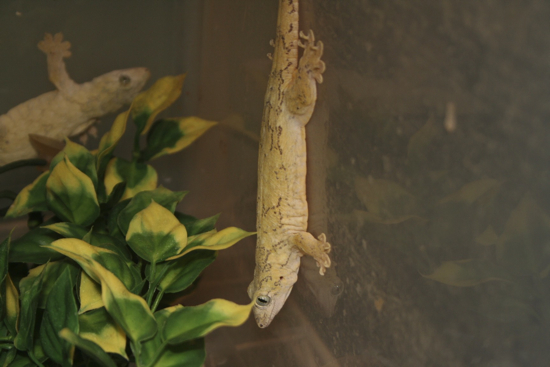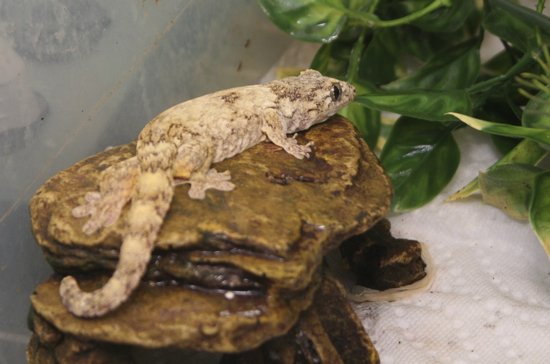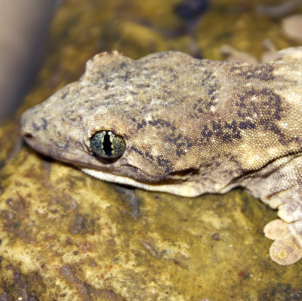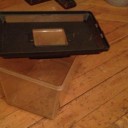Halmahera giant geckos (Gehyra marginata), sometimes erroneously referred to as “vorax geckos,” are large, arboreal geckos from the island of Halmahera in Indonesia. They are one of the largest species of gecko, attaining a total length of approximately 11 inches (30 cm), similar in size and shape to the tokay gecko (Gekko gecko), but often faster and much less aggressive. They are also sometimes called “the poor man’s leachie” as they grow impressively large but are often not particularly expensive to acquire.
[ad#sponsor]
The genus Gehyra contains several large gecko species, including the true vorax gecko (Gehyra vorax). Marginatas are often imported under this name, but no true vorax geckos have entered the United States in 30 years, and there is only one known elderly pair currently residing here. It’s usually safe to assume any gecko labeled vorax is unlikely to actually be that species.
Marginatas are usually cream or light brown in color while resting and darker or with more cryptic moss or lichen-like coloration while active. Juveniles are often brown or pinkish. Fully mature adult animals have jade-green eyes with black reticulation, and a black vertical pupil. Their feet are also particularly unique in having sickle shape appendages tipped with claws.
Housing
Halmahera geckos grow large and are very active, so should have adequately spaced terraria. They are most at home clinging to branches or vertical surfaces, so a vertically oriented cage is better. If a glass aquarium is being used, a 30 gallon tank on its side would house a pair. Commercially available terrariums with front-opening doors are also recommended. Substrate can be coconut fiber, newspaper or paper towel. They will drink water from a dish so providing fresh water at all times is a good idea, as well as nightly misting. They seem to prefer high humidity. This species also enjoys leafy cover so live or fake plants are recommended, as well as ground based caves or tubes for sleeping in during the day. They are not a particularly aggressive gecko, and female/female or male/female pairs can often be housed together, but, as with most lizards, not male/male pairs.
As for lighting, they do not require UVA or UVB lamps, a situation common to nocturnal species. They are also not particularly needy when it comes to heating. Most of the year, we keep them at room temperature, or around 72 degrees with a slight drop at night. During colder months, a small low wattage red heat lamp can be used (I usually use a 50 watt bulb), and they will occasionally bask under it. The warmest spot in the cage is not more than 80 degrees F.
Diet
When I first acquired this species, I had mixed information about proper diet for them. What seems to work the best is a staple diet of Repashy Crested Gecko Diet (sometimes referred to as “CGD”), which is a powdered meal replacement food that can be mixed with water. They will also eat as a treat most types of insects, and particularly seem to go after large crickets. We dust the insects and give them those about once a week. The CGD food is offered about every three nights. Very occasionally (not more than once every month) they are offered some fruit and in particular they greatly relish bananas. They also enjoy honey.
Handling
These are very fast geckos. Couple that with a peculiar defense they have of sloughing off big chunks of skin, and you have a potential recipe for disaster. Wild caught animals especially are known to be flighty and distrusting of human hands, although unlike tokay geckos, marginatas are not known for being aggressive biters. This is why most wild caught halmaheras are profusely scarred animals. As with most reptiles though, they are absolutely tame-able animals.
Do not restrict the animal in your hands. They are very fast, so attempting to handle them in the cage (especially front opening terraria) is the easiest way to start. Starting with younger, captive bred animals tends to make this easier as well. Mine were hatchlings bred in Florida, and tamed within a few months of regular handling. They are still more skittish than any of my crested or gargoyle geckos, but will allow me to hand walk them and will usually lick honey off my fingers. (This is a good way to get them to trust you actually).
Even if you don’t plan on attempting to tame them, they make really rewarding captives. They are some of my most active geckos, even moreso than my giant day geckos. They’re always prowling around their tank starting around 9:00 in the evening, and are often inquisitive about what I’m doing in the room, and not at all shy about coming out into the open once the lights are dimmed.
Breeding
I am still working with this species regarding successful breeding, and hope to have more information next year. Other keepers have communicated to us that breeding is induced with a slight cooling off and photoperiod, but may wll breed without taking this step. They prefer to deposit two eggs glued to the inner surface of a tube structure, such as a hollow piece of bamboo or PVC pipe. The eggs can be incubated in situ, or moved to an incubator and kept similar to Rhacodactylus eggs (i.e. room temperature). They take a good deal longer to hatch than many familiar species, sometimes as long as 6 months. The hatchlings, and I can confirm this firsthand, grow slowly and may take two or three years to fully mature.







Thank you so much for posting this! I have not been able to find anything on these guys until now.
Have Halmahera’s been successfully crossed with any other geckos?
Is there any where to get one of these guys?
Tanner, I just put mine up for sale today on KSL if you want to check it out.
Sweet thanks!
other care sheets say they need quite high temperatures?
I wasn’t sure how to care for these guys correctly Evan though I’ve wanted one for quit some time and now I can get one because I know how to take proper care of the gecko that’s going to be added to my reptile”collection” very soon
I have had my first two clutches of eggs this year from my wild caught pair. I bought them in late July of 2013 and they were both still growing. I got the clutches roughly seven weeks apart and will get back to you on how long the incubation time takes. I’ve heard lots of varied info on this species which has made it frustating as a first attempt at breeding but I feel confident these will hatch out in 4-5 months at 80 degrees. I’ve heard temps from “like cresteds” to 84 degrees and that they can easily take over 120 days to hatch (but at what temp?). They do not glue their eggs, mine weren’t and the only feedback I’ve had of gluing is for infertile eggs. My first clutch had one egg buried quite deep into the coco substrate and the other was right on top. Both times the eggs were buried inside of a 3″ wide hollow piece of bamboo shoved into the substrate. THEY LOVE THE BIG HOLLOW BAMBOO, most species do ; )
I am glad for any information on these guys. I bought a wild caught pair online. The male only lasted a few days. I am looking for more Halmaheras. Preferably captive bred.
I really like this care sheet. I’ll be getting my first in a couple days.
Beth – The one I’m getting is captive bred and the breeder has more available.
Thank you for the information. I am excited. Can I get you my contact information?
Of couse. Email me zebinsky@gmail.com.
They have then for sale on backwater reptiles! I love them!
Hey my gf was handleing my halamerhara gecko and my cat got ahold of him and tore a good chunck of skin is there any remedy i can do to help out with the healing process
Keep it clean and away from any substrate that might get into it. Geckos have amazing healing powers. Keep an eye on it and if you see swelling, pus or other signs of infection take it to a reptile vet as soon as you can.
I had our Halmahera Geko for 10+ years.
I just got a humidifier for him. Also got digital hygrometer.
He seams to have developed a skin condition on his paws. At first I thought it was dryskin. But not so sure anymore. His paws have been perfectly normal 4 weeks ago. If it is a fungus. What can I do for him ? The next veterinarian that treats reptiles is an hour away. We have 32 F at the moment..
I was unfortunate enough to buy a “captive bred” pair, that was actually wild caught… The male would bite the crap out of me when I tried to medicate him or feed him. They didn’t last long, since I’d never dealt with wild caughts before. Lesson learned for me.